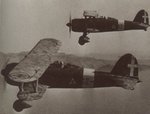cheddar cheese
Major General
Right, time to reincarnate an old topic...
What do you guys think the best biplane fighter was?
I say Fiat CR.42 Falco...
Discuss
What do you guys think the best biplane fighter was?
I say Fiat CR.42 Falco...
Discuss




